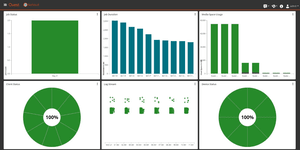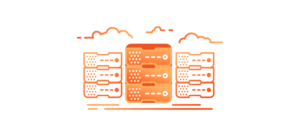
As businesses lean more heavily on digital technologies, a host of challenges emerge regarding storage, access, security, and compliance. Distributed storage plays a crucial role in modern data management, enabling organizations to manage large volumes of data across diverse infrastructures. It offers a scalable and resilient method for effectively storing data across your complex environment. This article delves into the multifaceted nature of distributed storage, exploring its benefits, challenges, and implications in today’s data-driven landscape.
What is distributed storage and how does it work?
Distributed storage can be viewed in multiple ways. In the context of a backup solution, it entails having multiple copies of data backups. However, when considering the broader development of a company, distributed storage refers to a method of storing data across multiple physical or virtual locations. Rather than centralizing data in one place, it is divided into smaller parts and stored on various devices, often located in different geographic locations. These storage devices are interconnected through a network, such as the internet or a local area network (LAN). Decentralized storage is commonly used in cloud computing environments, where data is replicated across multiple data centers.
Why should distributed storage be a priority for organizations?
Distributed storage addresses the complexity of managing data across different geographic locations. While a single-location setup might suffice for some companies, those with branch offices scattered across regions may face challenges with slower access times from distant areas.
There are also regulatory restrictions on data movement across borders. Countries like Finland or Norway enforce stringent regulations, compelling certain businesses to opt for local storage, despite being part of larger organizations. Even if centralized storage appears preferable in this situation, decentralized storage enables strategic placement of data, taking into account legal constraints, accessibility, and sheer data volume.
Relying solely on centralized storage poses risks, particularly in emergencies where immediate data retrieval is necessary. Storing backups alongside production data facilitates swift recovery for minor issues, such as a user deleting a file. However, when a major incident occurs, not only can the production environment be compromised, but backup data as well.
The right distance between production data and backup data depends on the issue an organization wants to protect itself against. With climate change, the risks of fire or flood are exacerbated. No matter the distance between the production environment and backup, distributed storage makes it possible to carry out a failover to another area in the event of a disaster. It offers IT resilience and strengthens business continuity, especially for companies operating in high-stakes environments.
What are the pros and cons of distributed storage?
Considering the advantages and disadvantages of decentralized storage starts with identifying the company’s needs. Understanding the organization’s specific requirements opens up various possibilities. For instance, if cost saving isn’t a priority, there may be options like opening additional locations that could benefit the organization. Ultimately, the pros and cons are contingent upon the unique needs of each business.
Pros
Scalability
Scalability isn’t really an optional feature, especially for companies dealing with large amounts of data. It’s more of a necessity than a choice. Depending on the volume of data you handle, scalability is a fundamental requirement.
Distributed storage systems are inherently scalable, allowing organizations to easily add or remove storage capacity as needed. This scalability allows for setups that are cost-effective, fast and resilient to faults.
Fault tolerance
Data redundancy ensures that if one storage device fails, the data remains accessible from other locations and the business can continue to operate without interruption. Redundant storage architectures often incorporate fault-tolerant mechanisms to detect and respond to failures automatically. These environments often switch to redundant components or backup resources to help maintain system functionality in the face of hardware or network failures.
Cost
Distributed storage often utilizes commodity hardware and open-source software, which can be more cost-effective than proprietary storage solutions. Additionally, it typically allows organizations to scale storage capacity incrementally, avoiding the need for large upfront investments.
Some systems incorporate data reduction technologies such as compression and deduplication, which can minimize storage footprint. By reducing the amount of data stored, organizations can save on storage costs over time.
Performance
Local access typically offers superior speed. However, by enabling parallel access across multiple locations, decentralized storage allows multiple users to access data concurrently from different locations. This improves throughput and reduces latency, particularly in environments with high levels of concurrent read and write operations. Caching mechanisms can also be used to store frequently accessed data closer to users to improve response times.
As data volumes grow and workloads increase, data can be distributed evenly across many components, improving overall performance.
Compliance
Compliance is not as straightforward as concepts like costs or security. It’s more so a behavioral requirement, where specific actions are necessary for adherence. However, unlike rigid directives, compliance often allows for interpretation and adaptation to specific contexts.
For example, a government initiative in Europe mandated a 3-2-1 rule without specifying details of how to comply. Because the 3-2-1 rule only dictates having two copies and doesn’t specify where or how to store them, different companies could implement the rule differently. Distributed storage could be part of that solution. While not a direct guarantor of compliance, it helps meet regulatory requirements with flexible options for data redundancy and geographic dispersion.
Privacy
Many distributed storage systems offer encryption features to protect data both at rest and in transit. By encrypting data before it’s stored and decrypting only when accessed by authorized users, they add an extra layer of security and privacy.
Decentralized data is also often stored across multiple servers, rather than in a single location. This decentralization means that even if one server is compromised, the entirety of the data remains inaccessible. It reduces the risk of a single point of failure and makes it harder for unauthorized parties to access sensitive information.
Cons
Bandwidth
While distributed storage can maintain multiple copies of data for redundancy purposes, it faces bandwidth limitations and accessibility issues. For instance, despite the widespread use of Microsoft 365, outages occur, causing disruptions. If companies are not able to reach their data, even a short interruption can be problematic.
Placing your data in dispersed storage means relinquishing some control. Organizations would need to rely on others to ensure their data’s availability. Data may be in another data center, accessible through various internet connections, any of which could fail. There might be situations where, due to unforeseen circumstances, connectivity is lost. Stepping outside of your controlled environment means accepting the risks associated with potentially unreliable connections.
Security
As aforementioned, when relying on another data center, you lose some control. If there’s a problem, it could affect access. But even if data is stored in another data center, companies are still responsible for securing their data. If there aren’t security guardrails in place, your data can be vulnerable to loss or theft.
There are measures you can take to secure distributed storage, but it’s not inherently secure out of the box. You need to ensure encryption, access control and so forth and set up mechanisms to protect your data.
Data protection
If security controls aren’t configured properly, your data protection strategy could be at risk. When data is distributed across multiple locations or stored in the cloud, it becomes more vulnerable to security breaches or unauthorized access. If encryption protocols are not utilized effectively or authentication is mismanaged, data may be exposed. Without adequate safeguards in place, the complexity of dispersed storage environments can increase the risk of data breaches or loss.
How does tiering play into distributed storage?
Distributed storage can be approached from a production standpoint. Here, it’s logical to store business-critical data or frequently accessed information in a different tier than data that is two years old. If you have a substantial amount of data, it makes sense to use tiered storage in your production environment. This is also relevant when considering tiered storage for your backup environment, especially now that more companies see cloud storage as a viable secondary copy for backups.
Specifically for backup data, there will be varying recent retention periods. For instance, you may want to keep one backup for five years and another one for only two weeks. Within backup systems, there is a clear need for tiering, particularly when dealing with cloud storage and its associated costs.
When you approach a cloud vendor to store data, they usually charge based on how often the data is accessed. Data is categorized as either “hot” or “cold.” However, most vendors require you to determine that classification yourself. If you misjudge it and place data in the wrong tier, you might end up paying a higher price, as the cost differs significantly between these tiers.
Another consideration with tiering is the need for fast access to disaster recovery data. In such cases, tiering ensures that critical data is stored on faster storage mediums, while older, less frequently accessed data may reside on slower disks or even in the cloud. This approach to tiering in backup storage isn’t solely based on cost, but also considers access speed.

Protect all your systems, applications and data.
What mistakes do organizations make when it comes to distributed storage?
Many companies fall into the trap of misunderstanding the costs associated with decentralized storage. They might initially perceive cloud storage as a budget-friendly solution, only to realize later that it’s not as cost-effective as they thought.
Mistakes also stem from overlooking security considerations and underestimating the accessibility of data stored in the cloud. Some organizations discover that retrieving data in the event of a disaster isn’t as fast as anticipated. The error lies in failing to understand the full spectrum of pros and cons associated with dispersed storage and focusing only on one aspect. Just pinpointing the cheapest solution is not sufficient.
To determine if distributed storage is suitable, you must first understand your own needs and identify what you’re looking for. Distributing storage is a methodology and an ongoing commitment, not a one-time action.
Conclusion
Distributed storage ensures that businesses can accommodate large amounts of data without sacrificing performance or incurring substantial costs. But beyond addressing the immediate challenges of data volume, scalability, and cost, it also signifies a profound change in how organizations perceive and interact with their data. By embracing distributed storage solutions, businesses can leverage data assets to the fullest, enhancing accessibility and resilience and driving sustainable growth.



